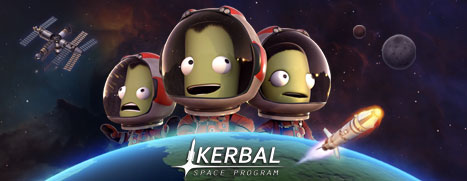
Squad's Felipe Falanghe is the creator and lead developer of Kerbal Space Program, and his work space feels a lot like a command module in a rocket soaring to Mun. When he's not busy developing one of PC gaming's most delightful simulators, he's using a gigantic array of peripherals to play games. Felipe was kind enough to take a few moments away from firing Kerbals into space to tell us about his setup.
What's in your PC?
On the inside, my current PC specs consist of an Intel Core i7 3820 CPU, 32 GB DDR3 RAM, a GeForce GTX 690 GPU, a Samsung 840Pro 512GB SSD, a 2TB 7200 rpm HD, a 1kW PSU, all aboard a CM Storm Trooper Case.
What's the most interesting part of your setup?
I have to say, I love my peripherals. I have a thing for human interface devices, and I ve been collecting them since I had my first PC. As for a favorite, I really had to think about that for a while but if I had to pick one thing, that would have to be my Matrox TripleHead2Go and the 3 screens.
What's on your desk?
On the "main deck," we have a Logitech X550 5.1 Surround System, Another 1TB Toshiba external drive, a G19s Keyboard, 3DConnexion s SpaceMouse and SpaceNavigator, RAT 7 Mouse, F350 Gamepad, the Saitek X52 Pro, a 4-port USB Hub, TrackIR 5, MS VX1000 webcam, and the monitors, 2 LG 1920h LCDs (left and right), and an LH E1910 at the center. The three used to be the same model, but one of them sadly burned out a while back. On the "lower deck," I have a Logitech G13 and a Razer Nostromo, plus my trusty Wacom Intuos 3 Tablet. Under the desk, sit the ProFlight Rudder Pedals and the pedal set for the Driving Force GT Wheel. The wheel itself takes the desktop front and center when it s time to drive, and the right rudder pedal doubles as a clutch pedal. For flying, the Saitek X52 Pro takes center stage.
What are you playing right now?
I really haven t had much time to play much at all in these last few months I did manage to get a few hours in on Assassin's Creed 4: Black Flag these last couple of days, and before that, I was playing Just Cause 2, Skyrim some indies as well, like Papers, Please and The Stanley Parable. And DayZ, lots of DayZ.
What's your favorite game and why?
Now that is a properly hard question I m very picky about games, because I usually dedicate a lot of time on a single title, so I definitely have a few favorites of recent times, DayZ being one, but I ve always been a big fan of all of Bohemia s Arma series all the way back to the original Operation Flashpoint.
An all time favorite though, that s very hard to pick I do have a few which have stuck with me since I was little, some of which I still get around to playing every now and then, on emulators or VMs. I think Fragile Allegiance, from 1995, has to be my favorite strategy game. I was playing it again just a few weeks ago on my laptop, running DOSBox. For RTS, I would say Total Annihilation. For flight sims, Microsoft s Flight Simulator series, definitely. I ve had all of them since MSFS 4.1, which came on a single 3.5 floppy, all the way through FSX. I couldn t leave out Orbiter either. I ve been an Orbiter fan ever since I first played it back in the early 2000 s.
I have a few console favorites too, although you can probably tell from those pictures I m not a console gamer most of the time. My favorites are from the N64 era. Of all those, I would put GoldenEye 007 at the very top. I actually never owned it, I used to rent it at Blockbuster pretty much every weekend, and I got so many hours into it, I have some of the levels forever burned into my brain, to the point I could map it out by memory. And of course, I couldn t not mention SimCity 2000, 3000 and 4, and The Sims as well.
I know this is hardly a definitive answer, but these games were the worlds I would live in when I was a kid, then through my teenage years and college days, so they ve all influenced me as a game designer now, and I still refer to them as my role models for fun and immersive games.












